You may have noticed a flurry of articles and posts about some big things afoot at Google. Or maybe you’ve even seen a significant change in traffic Google sends to your website.
If so, it’s not a fluke. A handful of recent events have radically affected the search engine giant, from how it shows search results to how ads are created and run on the platform.
Whether you actively focus on search marketing or passively get customers from Google, these events will likely impact your business. So, we’re giving you the 10,000-foot view of the most significant Google updates.
Here are the top four Google updates to be aware of:
- Google expanded its use of AI Overviews
- Documents about Google’s algorithm were leaked
- Google announced new AI-powered ad features at Google Marketing Live
- Google’s recent core updates redistributed organic search traffic
1. Google expanded its use of AI Overviews
If you’ve used Google lately, you may have seen a new feature at the top of the search results that looks like this:
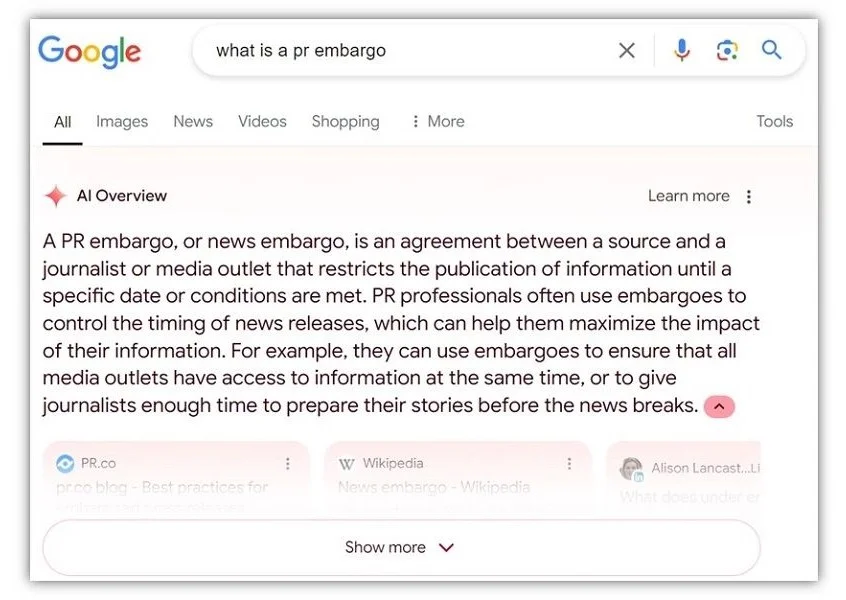
Google fully released AI Overviews in the US with the intention of helping users get answers from the search engine faster.
Google calls them AI Overviews, and they’re completely changing how the search engine works for users, creators, and marketers (and it’s not all good).
🚨 Search engine marketing is getting more competitive. Make sure your website is in fighting shape with our free Website Grader.
What happened?
On May 14, Google announced it was rolling out AI Overviews to every Google user in the US, with other countries soon to follow. Google ran an earlier version of the feature—known as Search Generative Experience, or SGE—for a year prior as an experiment with a limited number of users who opted into Google Labs.
AI Overviews use machine learning to give users AI-generated answers to their queries on the search engine results page. Google creates these answers by sourcing info from existing websites and from its Knowledge Graph (which Google describes as its “database of billions of facts about people, places, and things”).
Why it matters
Google’s AI Overviews may lead to a significant loss in organic search traffic for many websites.
Loss of trust in search engines
Machine learning algorithms have limitations that sometimes allow them to produce incorrect answers. For Google’s AI Overviews, this has led to some embarrassing results that are damaging the search engine’s reputation and could push users to find alternatives (meaning less traffic for websites from Google).
Not long after the May 14 announcement, people started sharing screenshots of some ridiculous answers cobbled together in AI Overviews.
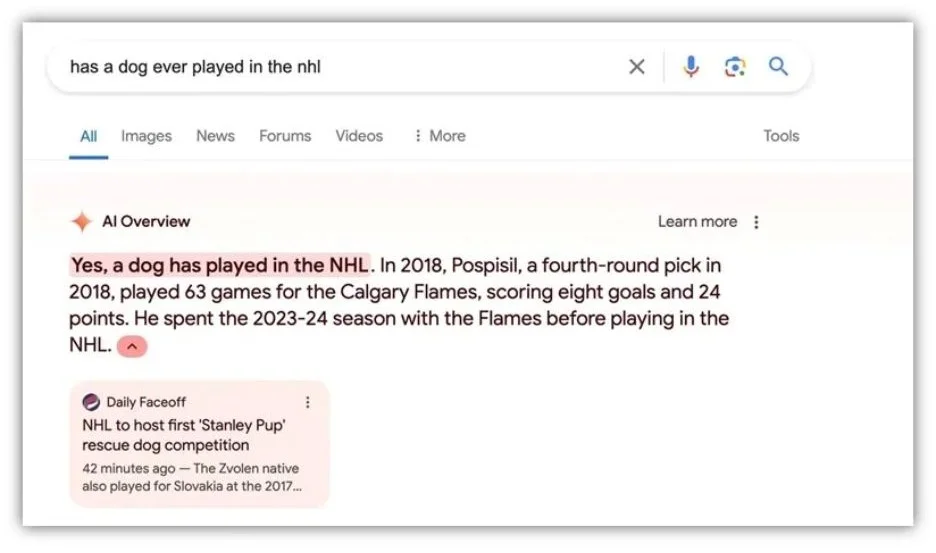
Google users shared several screenshots of AI Overviews filled with incorrect information.
In some cases, the responses surfacing on search pages were downright dangerous, suggesting harmful solutions to users’ questions.
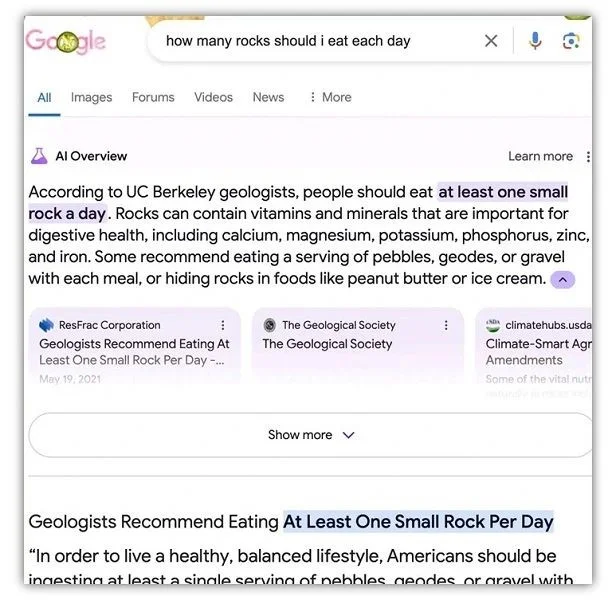
Some AI Overviews offered incorrect health advice.
At other times, Google’s AI leaned on outdated or even completely dead websites to inform its answers, so users who clicked a link didn’t have a good experience.
Google is facing backlash for the erroneous AI Overview responses. Many industry experts suggest that the search engine’s reputation and possibly its dominant position are at risk. Consumers have already started using TikTok and other platforms as search-engine alternatives, which could hasten that migration. This could mean an eventual shift in where we spend our marketing efforts.
Throttling organic traffic to legitimate websites
Google’s AI Overviews take up a significant amount of screen space. Your potential customer must scroll further down the page to find your link. It’s worse on mobile devices, where long stretches of screen real estate get taken over by AI answers.

Google’s AI Overviews dominate the top of search engine results pages, forcing users to scroll to find organic links.
Not only are organic links pushed down the page, but many users may not need to click on them at all. That’s because the AI-generate responses are designed to answer questions quickly from the SERP. If users find all the information they need in the AI Overview, the websites publishing content won’t get traffic from those searches (even though their content likely fed Google’s AI).
The loss of organic traffic could be huge. One estimate suggests that organic search traffic could drop 25% by 2026 because AI chatbots and virtual agents (like Google’s AI Overviews) will answer many searchers’ questions.
2. Documents about Google’s algorithm were leaked
Google has always kept the rules it uses to rank content close to its chest. A recent information leak provided the largest cache of details on how Google’s algorithm works to date.
What happened?
On May 27, Rand Fishkin—a well-known voice in the SEO space—published a blog post stating that an anonymous source (he has since come forward) shared 2,500 pages of Google API documentation. The documents were first accidentally leaked to a public repository, possibly months earlier. But this was the first big public exposure of the leak.
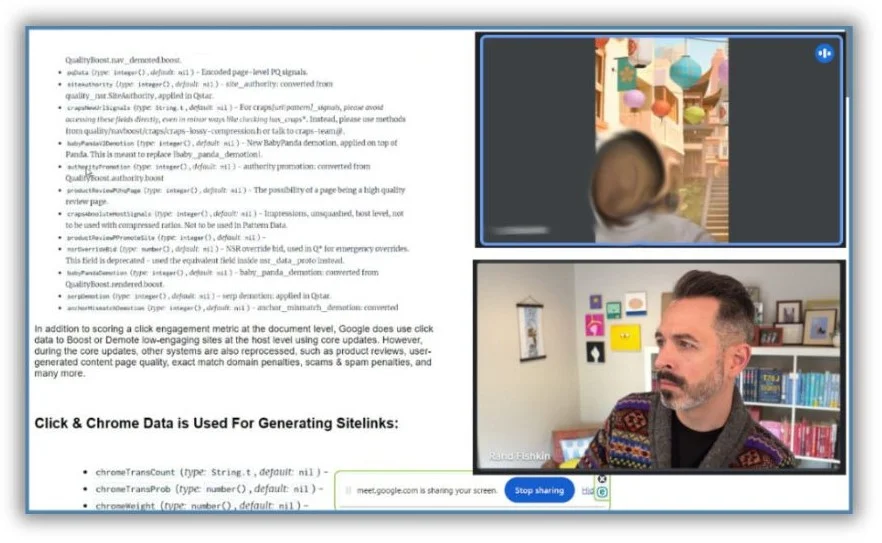
Rand Fishkin shared this screen capture of a conversation with his source.
Another SEO expert, Mike King, dove deep into the documentation shortly after Fishkin published his post. King noted that the documentation doesn’t necessarily state how Google weights and ranks content for results pages. Instead, it shows which characteristics and data Google’s systems track and store, an indication of what it may use to rank content.
Why it matters
The more we know about how Google ranks content, the better chance we all have of creating content that ranks better.
Simple, right?
Unfortunately, Google doesn’t publicly share the full breadth of its ranking factors. Google spokespeople are often accused of not telling the whole truth or even using semantics to give misleading answers.
As King and other SEO experts continue to analyze the documentation, we’re learning more about what Google’s systems may use to rank content. Some of these findings seem to contradict statements made by Google employees in the past.
For example, King notes that Google spokespeople have said dwell time (the amount of time someone spends on a web page after clicking from a search results page) is not considered a ranking factor. However, the leak provides evidence that Google is at least measuring this metric as part of its algorithm.

Mike King found evidence in the leaked documents that Dwell time may be a ranking factor, even though Google employees have said it isn’t.
There’s already debate over what the documentation tells us about actual ranking signals, which signals actually matter, and which are being misunderstood by the experts reviewing the leaked information. We’ve reviewed a lot of what’s out there. Here are the five biggest takeaways we learned.
3. Google announced new AI-powered ad features at Google Marketing Live
Google constantly adds new features and capabilities to its Google Ads platform for marketers. Once a year, the company announces the biggest of these additions at its Google Marketing Live (GML) event.
💡 Are you paying too much for ads on Google? Download the free Search Ads Benchmarks Guide to see how your search ads costs stack up against others in your industry.
What happened?
On May 21, nine high-level Google employees presented 30 new Google Ads features at the 2024 Google Marketing Live keynote address.
Here are a few highlights from what Google announced:
- AI Overview ads: Ads automatically placed in the middle of AI Overviews.
- AI-powered creative asset production: Create video from static images, add clickable stickers, add backgrounds and features to product ads, virtual try-ons for apparel ads, 3D product images, and more.
- Ads Data Manager: A new platform that lets you gather and visualize first-party data from several sources.
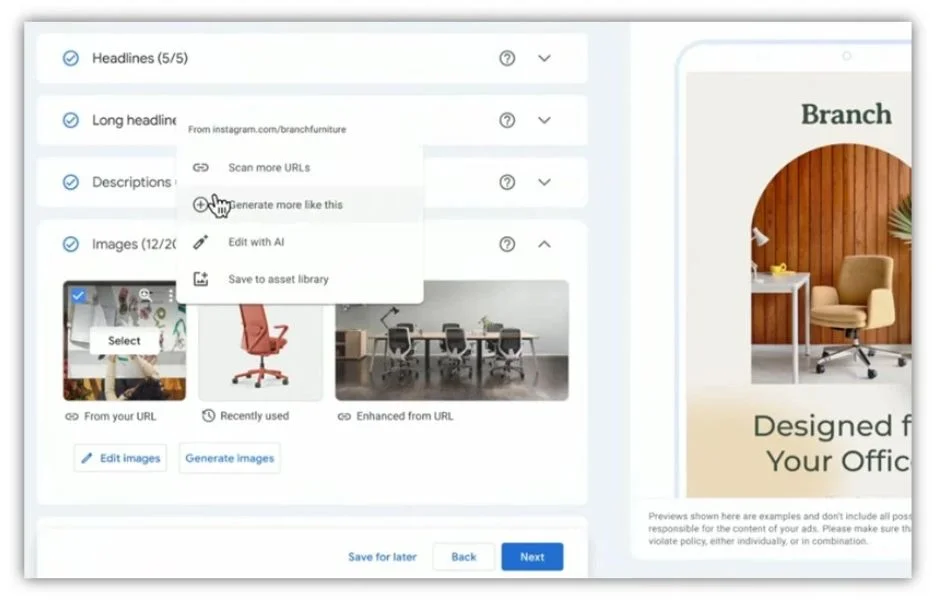
Google has released several AI-powered features that allow marketers to produce ad creative faster.
And here’s a full recap of the most important announcements from GML 2024.
Why it matters
Google Ads is one of the most popular and effective ways to generate leads and sales online. New features that improve ad creation, targeting, and analysis should help many marketers do that.
One bit of feedback we heard from several experienced pay-per-click (PPC) marketers was that the products and presentation were too heavily focused on helping large companies from a few industries. Specifically, big travel and retail brands can use the new AI-powered ad features to sell their products. However, smaller businesses, B2B brands, and others outside those two industries won’t get as much use from the features.
4. Google’s March core update throttles traffic for many websites
Google constantly tinkers with its algorithm, changing how it decides which web pages rank highly on results pages. Many of those smaller changes barely register with users and marketers. A few, called core updates, can completely reshuffle result-page rankings.
What happened?
In March 2024, Google began rolling out a large core update aimed at reducing the amount of unhelpful content appearing in search results. According to Google, the updates, in conjunction with other work, “will collectively reduce low-quality, unoriginal content in search results by 40%.”
Google also said this update was more complex and sweeping than previous versions. It wasn’t completely rolled out until mid-April.
Why it matters
Ever since the March core update, search result pages have been extremely volatile (meaning many sites are seeing their rankings fluctuate). This led to some websites losing a lot of organic traffic almost overnight.
Could the websites that lost traffic have been penalized for publishing low-quality, spammy content?
Ideally, that’s what the March core update was supposed to do. In reality, many legitimate websites that produced content based on first-hand data and experiences (the kinds of things Google says it wants) lost much of their organic traffic. Meanwhile, spammy websites are showing up more on search result pages.
For example, an obviously AI-generated blog post that’s basically a massive wall of overly optimized text outranked UPS for a keyword about returning packages to UPS.
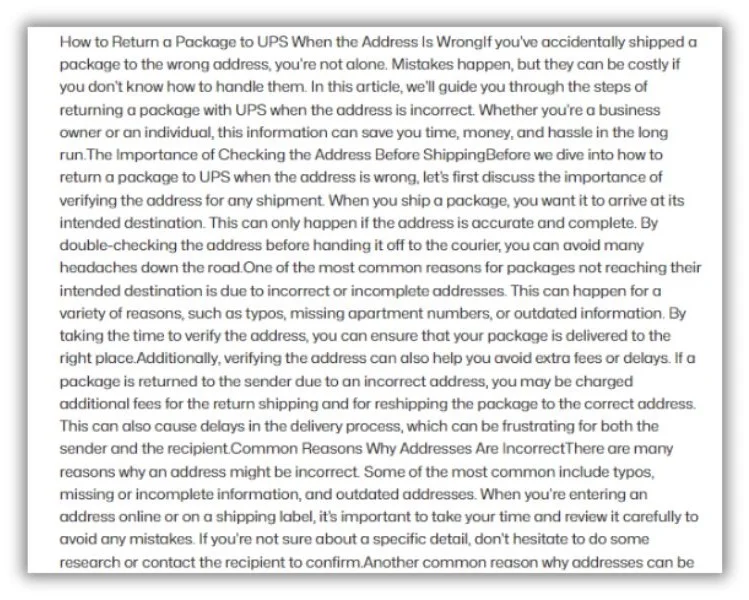
Google’s March core update was supposed to keep spammy content like this off results pages, but many are gaining more ground than ever.
You may have experienced volatility in your own rankings and organic traffic. If so, hold on because it’s unclear when things will level out.
What’s next for search engine marketing?
A lot of dust is still in the air from current updates and announcements. Google has started to address the problems with its AI Overviews. Experienced SEO pros continue to offer their analyses of the algorithm leak. Who knows what the final result of the core updates will be?
Our best advice for now is to continue prioritizing your customers in everything you create and publish, follow current SEO best practices, and stay tuned as we’ll share updates and advice from experts.






